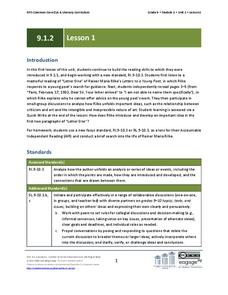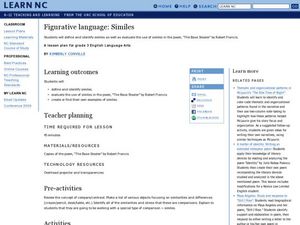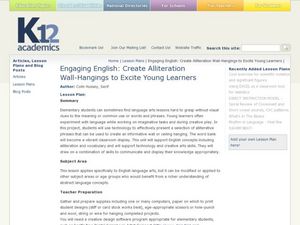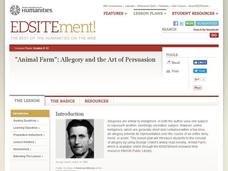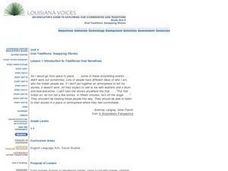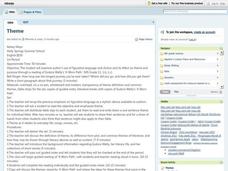Curated OER
Setting the Tone with Figurative Language
Explore figurative language with your secondary class. Extending a language arts unit, the lesson prompts middle schoolers to examine how an author's word choice establishes a story's tone, possibly using metaphors, similes,...
Curated OER
A Modest Proposal: Irony Made Understandable with Rock and Roll
Who doesn't love music? Poems and songs will engage your high school class in a discussion about irony. Use songs like "Rockin' in the Free World" or "Born in the U.S.A." to illustrate the ironic point of view. Print the lyrics so...
Curated OER
Poetry Beyond Words
Participate in writing poetry as a group. Focused on a given theme, young writers compose a popcorn poem using sensing verbs and adverbs. They write popcorn poems, onomatopoeias, collective poems, and diamond poems. You could introduce...
EngageNY
Grade 9 ELA Module 1, Unit 2, Lesson 7
Readers analyze David Mitchell's techniques for introducing and developing the mystery surrounding Madame Crommelynck in the "Solarium" chapter of his novel Black Swan Green.
EngageNY
Grade 9 ELA Module 1, Unit 2, Lesson 1
Where does a writer find inspiration? "Go into yourself," says Rainer Maria Rilke in "Letter One" from Letters to a Young Poet. Readers of Rilke's letter to Franz Xaver Kappus examine the words and figurative language Rilke uses to...
Curated OER
Language Arts: Creative Writing Devices
Eighth graders review sound and rhythm devices and apply them to their own writing exercises. Next, they interpret the poem, "Where I'm From," as an example of a personal narrative. Using their understanding of poetic devices, they...
Curated OER
Edward Lear, Limericks, and Nonsense
Introduce your class to the delights of nonsense poetry and explore literary devices with the writing of Edward Lear. Learners identify rhyme and meter as well as figures of speech, alliteration, and onomatopoeia in "The Owl and the...
Curated OER
The Synagogue on Praska Street
Young scholars discover the significange of a synagogue that was destroyed during World War II. As a class, they identify and describe Jewish symbols and are introduced to Croatian Jewry. They review the characteristics of a minority and...
Curated OER
Figurative Language Similes
Learners illustrate a simile. In this figurative language lesson, second graders are introduced to similes. They read the story Quick as a Cricket and talk about the similes used. Everyone chooses a simile and draws a picture to go along...
Pearson
Lesson Plan: Introduction to Plato’s Cave
Can we perceive reality or are we chained by preconceptions that limit our vision? Plato’s allegory “The Cave” serves to introduce nascent philosophers to Plato’s dialogues and hopefully to engender a love of ideas and discourse. A...
K20 LEARN
Nose Like a Cherry: Understanding Similes and Metaphors
Clement Moore's "Twas the Night Before Christmas" models the power of descriptive language for middle schoolers. They identify the similes and metaphors in the tale and consider what these descriptions add to the story's emotional...
Curated OER
"The Story of an Hour" Lesson 3: Teacher's Guide and Notes
The third lesson in "The Story of an Hour" series introduces young readers to analogies; a literary device writers use to add depth to their stories. Instructors identify the three analogies in the tale, and class members consider the...
Curated OER
Engaging English: Create Alliteration Wall-Hangings to Excite Young Learners
Learners explore the concept of alliteration. In this sound devices lesson, students use educational software to create alliterative phrases that are accompanied by appropriate clip art, design tools, and graphics.
Curated OER
This Isn't Your Little Sister's Poetry: Analyzing and Understanding a Variety of Acclaimed Poets
Eleventh graders are introduced to various basic and advanced poetic devices. They read several poems and practice identifying poetic elements. They identify at least two different poems and substantiate why they belong in the canon.
Curated OER
Chocolate Chaos
Second graders demonstrate the ability to examine the elements of a story (theme, plot, setting, mood) and characters, by discussing and writing about each. They have fun with chocolate related activities and enjoy reading about some...
National Endowment for the Humanities
Animal Farm: Allegory and the Art of Persuasion
Introduce your class members to allegory and propaganda with a series of activities designed to accompany a study of George Orwell's Animal Farm. Readers examine the text as an allegory, consider the parallels to collective farms...
Curated OER
Poetry and Paintings: A Comparative Study
Students find words for different feelings: sad, happy, annoyed, bored, puzzled, etc.
They think of colors which seem to fit each feeling. A painting is introduced and they are asked to verbalize how it makes them feel. What mood does...
Curated OER
Getting to Know You
Students complete a survey of interests to allow the teacher to become quickly acquainted with each student and introduce themselves using an alliterative adjective that best describes their personality.
Curated OER
Seeing the Image in Imagery: A Lesson Plan Using Film
In our increasingly visual society, it is often difficult for some readers to create a mental picture of a picture created only with words. An image-rich text like F. Scott Fitzgerald's The Great Gatsby can therefore, present a real...
Curated OER
Teaching Selected Poems from Jim Wayne Miller's the Brier Poems
Students explore the basic elements of poetry through Appalachian life poetry. For this poetry lesson, students read seven poems from Jim Wayne Miller's the Brier Poems and complete poetry analysis activities for each poem.
Curated OER
The Cask of Amontillado
Students examine the Edgar Allan Poe story "The Cask of Amontillado." In this character lesson, students discuss and analyze the characters in the story. Students make personal connections to the characters and create a brochure...
Curated OER
Introduction to Traditional Oral Narratives
Students are introduced to the idea of traditional oral narratives and divide them into genres. They explore the genres of context, motifs and variants. Each student finds oral narratives in their own lives and practice retelling them in...
Curated OER
Onomatopoeia Poems
Students write onomatopoeia poems. In this creative writing instructional activity, students listen to a picture book that introduces the concept of onomatopoeia. Students create their own list of words and write a short poem using...
Curated OER
Theme
High schoolers investigate the concept of theme and how it is used in literary works. They read a variety of texts looking for the theme in each of them. Students also differentiate between the plot and theme by using a correct...




